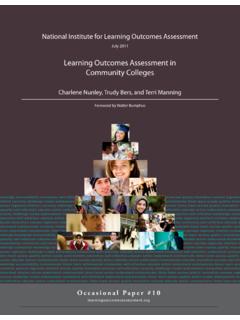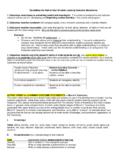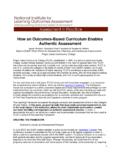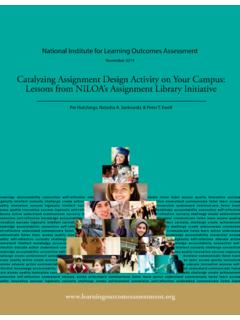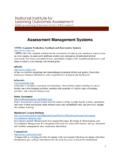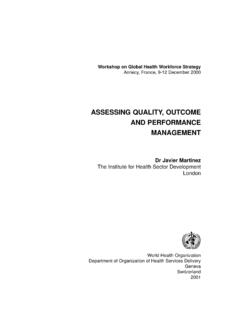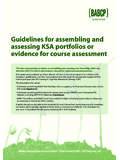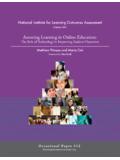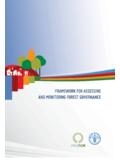Transcription of Equity and Assessment: Moving Towards Culturally ...
1 National Institute for Learning Outcomes assessment January 2017. Equity and assessment : Moving Towards Culturally Responsive assessment Erick Montenegro and Natasha A. Jankowski nowledge accountability connection self-reflection educate action under stand communicate listen learn access quality innovation success ngenuity intellect curiosity challenge create achievement connection self-reflection educate action under stand communicate listen learn access uality innovation success ingenuity intellect curiosity challenge knowledge accountability connection under stand communicate listen learn ccess quality innovation success ingenuity self-reflection educate action under stand intellect knowledge accountability connection self-reflection ducate action under stand communicate curiosity challenge
2 Create achievement connection self-reflection curiosity challenge create achievement onnection self-reflection knowledge accountability connection self-reflection educate action under stand communicate listen learn access quality nnovation success ingenuity intellect curiosity challenge educate innovation success ingenuity intellect curiosity challenge create achievement nowledge accountability connection self-reflection educate action under stand communicate curiosity challenge create achievement connection elf-reflection under stand communicate listen learn access quality action educate action under stand communicate listen learn action under stand ommunicate listen learn access quality innovation success ingenuity intellect curiosity challenge knowledge accountability connection access uality self-reflection curiosity challenge create achievement learn access quality innovation success ingenuity self-reflection educate action nder stand intellect knowledge accountability connection self-reflection educate action under stand knowledge accountability connection self- eflection educate action under stand communicate listen learn access quality innovation success ingenuity intellect curiosity challenge connection nowledge accountability connection
3 Self-reflection educate action under stand communicate listen learn access quality innovation success ingenuity hallenge create achievement connection self-reflection educate action under stand connection self-reflection under stand communicate listen learn ccess quality action create achievement connection self-reflection educate action under stand communicate listen learn access quality innovation uccess educate action communicate listen learn access quality action educate action under stand communicate educate innovation success self- eflection knowledge accountability communicate listen learn achievement connection self-reflection educate action under stand communicate listen earn access quality innovation success ingenuity intellect access quality innovation success self-reflection curiosity challenge create achievement onnection self-reflection under stand educate action under stand communicate listen learn action under stand communicate listen learn access uality innovation success ingenuity curiosity challenge create achievement connection self-reflection under stand communicate listen learn Oc c a s i o n a l Pa p e r # 2 9.
4 National Institute for Learning Outcomes assessment | 1 Table of Contents NILOA Mission Equity and assessment : The National Institute for Learning Moving Towards Culturally Responsive Outcomes assessment 's (NILOA) primary Limiting Learning objective is to discover and disseminate the ways that academic programs and Culturally Responsive institutions can productively use assessment Student Learning Outcomes data internally to inform and strengthen undergraduate education, and externally to assessment communicate with policy makers, families, and other stakeholders. Use of assessment Final NILOA National Advisory About Please cite as: Montenegro, E.
5 , & Jankowski, N. A. (2017, January). Equity and assessment : Moving Towards Culturally responsive assessment (Occasional Paper No. 29). Urbana, IL: University of Illinois and Indiana University, National Institute for Learning Outcomes assessment (NILOA). National Institute for Learning Outcomes assessment | 2 Abstract As colleges educate a more diverse and global student population, there is increased need to ensure every student succeeds regardless of their differences. This paper explores the relationship between Equity and assessment , addressing the question: how consequential can assessment be to learning when assessment approaches may not be inclusive of diverse learners?
6 The paper argues that for assessment to meet the goal of improving student learning and authentically document what students know and can do, a Culturally responsive approach to assessment is needed. In describing what Culturally responsive assessment entails, this paper offers a rationale as to why change is necessary, proposes a way to conceptualize the place of students and culture in assessment , and introduces three ways to help make assessment Culturally responsive. National Institute for Learning Outcomes assessment | 3 Equity and assessment : Moving Towards Culturally Responsive assessment Erick Montenegro and Natasha A. Jankowski Introduction College enrollment has become increasingly diverse in terms of students'.
7 Race, ethnicity, gender identity, socioeconomic status, sexual orientation, Conducting assessment in age, ability, etc. This trend is only expected to continue as the United a manner that takes into States moves into a majority-minority nation by the year 2050, and college enrollments continue to increase. Conducting assessment in a manner that consideration the various takes into consideration the various needs of different student populations is needs of different student a responsibility of higher education. For one, underrepresented students are populations is a responsibility more likely to be low-income and first-generation (Del Rios & Leegwater, of higher education.)
8 2008; Li & Carroll, 2007; Benitez, 1998), and there are vast differences between the needs of lesbian, gay, bisexual, transgender, queer, intersex, asexual (LGBTQIA) (Check & Ballard, 2014; Mallory, 2009), undocumented (Kim & Diaz, 2013; Perez, 2010), nontraditional (Macqueen, 2012), and special- needs students attending higher education institutions (Froese-Germain &. McGahey, 2012). Further, students are increasingly mobile, with transfer students coming from mostly traditionally underrepresented backgrounds, attending multiple institutions (Backes & Velez, 2015; Shapiro et al, 2012). and facing their own challenges in higher education (Tobolowski & Cox, 2012).
9 Various areas of higher education are aware of the need to accommodate different student populations because individual differences are clearly important to student success (Strange & Banning, 2015, p. 61). For example, approaches to teaching, student development, student services, and campus programs have been analyzed and altered to improve outcomes for specific student groups (Ladson-Billings, 1995a; Ladson-Billings, 1995b;. Schuh, Jones, Harper, & Associates, 2011; Kezar, 2011; Lara & Wood, 2015; Bowen, Chingos, & McPherson, 2009, Aronson & Laughter, 2016). Within the field of campus advising, the issue of microaggressions through lack of cultural awareness has been raised (Chu, 2016) and the work of the Association of American Colleges and Universities (AAC&U) in their Equity Imperative outlines the need to understand who students are, disaggregate data to look for inequities, and explore policy changes for unintended impacts on student groups.
10 Conversations in K-12 have addressed the notion of Equity from the standpoint of Equity traps (McKenzie & Scheurich, 2004). within schools and the need to prepare school leaders to not only expose but address them through courageous conversations about inequities (Singleton, 2012). In a literature review of Culturally responsive school leadership, Khalifa, Gooden, and Davis (2016) argue that Culturally responsive leaders need to continuously support minoritized students through examination of assumptions about race and culture. Further, they argue that as demographics continue to shift, so should practice that responds to student needs, finding that it is deleterious for students to have their cultural identities rejected in school and unacknowledged as integral to student learning (p.)
